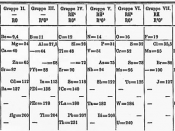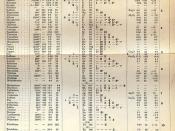The periodic table was first discovered about 200 or more years ago.
In 1869, the German chemist, Julius Lothar Meyer and the Russian chemist, Dmitri Mendeleev, separately published results which supported the ideas of periodicity suggested a few years earlier by John Newlands. Meyer plotted various physical properties (melting points, boiling points, density) of the known elements against their relative atomic masses. The first graph was obtained by plotting molar volume against the relative atomic mass; he noticed that elements in the same chemical family occurred at similar points on the curve. E.g. lithium, sodium and potassium appeared on the peaks whilst fluorine, chlorine and bromine appeared just before the peaks. Although Meyer's curves showed a periodic repetition of properties with relative atomic mass, most of the credit for arranging the elements in a periodic table is given to Mendeleev.
Mendeleev arranged the 60 or so elements known to him in order of increasing relative atomic mass, and showed that elements with similar properties recurred at regular intervals.
His first table showed that elements with similar properties fall in the same vertical column. These columns of similar elements are called groups and the horizontal rows of elements are called periods. Mendeleev's table had gaps; he left gaps in his table in order that similar elements would fall in the same vertical column. What is more, he suggested that, in due course, elements would be discovered to fill these gaps and he also predicted properties for some of the missing elements. Within Mendeleev's own lifetime some of these missing elements were discovered and their properties coincided very closely with his predictions. Mendeleev also proposed that periods 4, 5, 6 and 7 should contain more than seven elements. In order to fit these longer periods into his pattern, he divided them...


